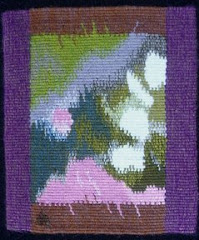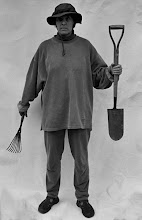May is blue, at least this year it is. Blue, with green and black and white. I am using this year’s diary to explore ways to add color to my black and white tapestries, although I forgot all about that this month! 
Just to mix things up a bit, I broke some of my parallelograms into 4 pieces. Then I had a revelation: you can break a parallelogram into 2 triangles! What fun. After one week of triangles, I was sad that I couldn’t see the parallelograms any more, so I thought I would try to keep the 2 triangles in each day similar in color, and then have a more noticeable difference between each day. The last week, because I was always weaving light, then dark, I ended up with a surprising chevron pattern. I love this kind of surprise.
I weave a parallelogram every day. That pattern started years ago as a variation on lazy lines, just using different colors. It avoids slits. Every month I change the color scheme, and also the direction. On the bottom line of the May photo you can see the last 2 days of April on the right side, then the number 5 for the first day of May on the left. There is always a triangle at the intersection.
Until I wove the last day of May, I had no idea what I would do in June, but now I have a plan. Check back in a month, and I’ll post a photo of the first 6 months.
For links to the 2010 Tapestry Diary click here.
Here are some links to the 2012 Tapestry Diary




 While I was away I visited the Textile Museum in Washington DC, and saw a wonderful tapestry by Archie Brennan (see the previous
While I was away I visited the Textile Museum in Washington DC, and saw a wonderful tapestry by Archie Brennan (see the previous 
 Did I mention I have
Did I mention I have 

